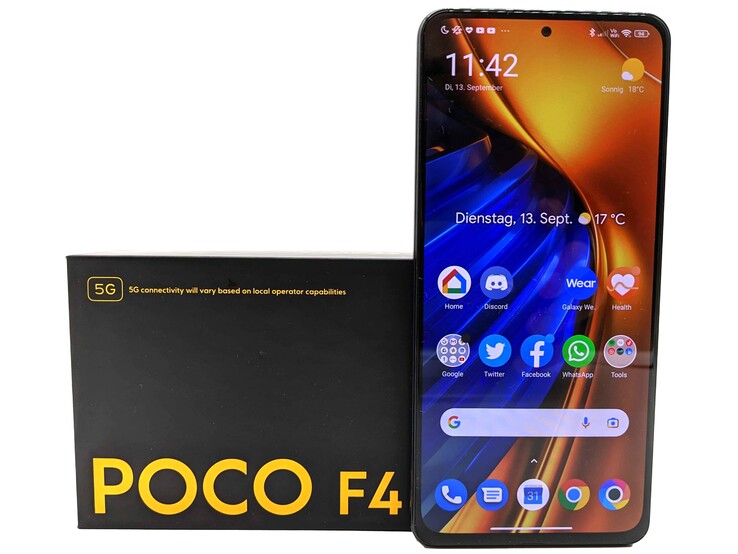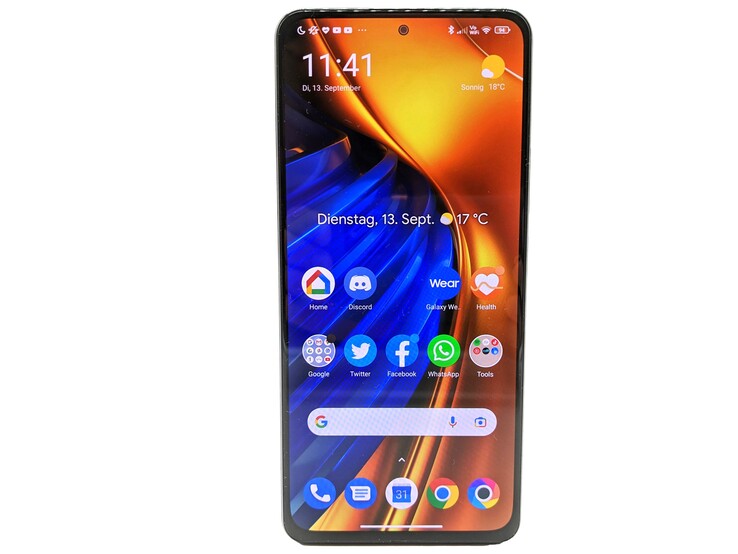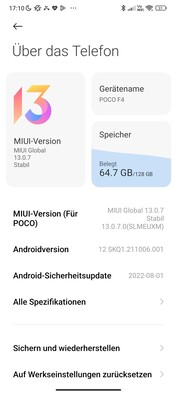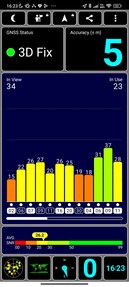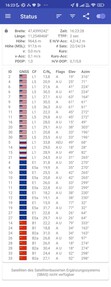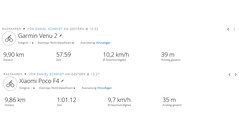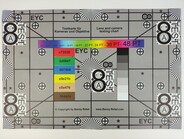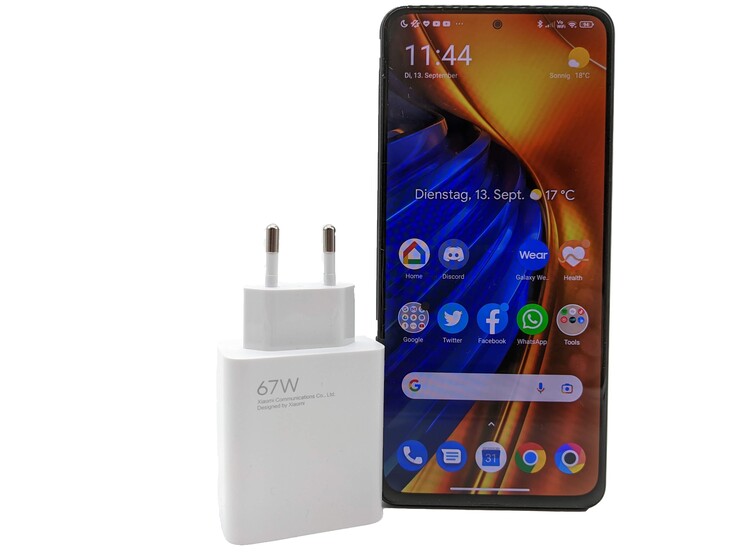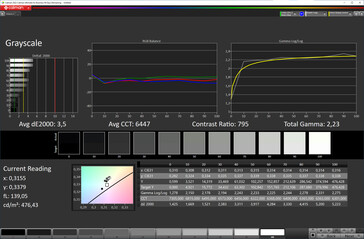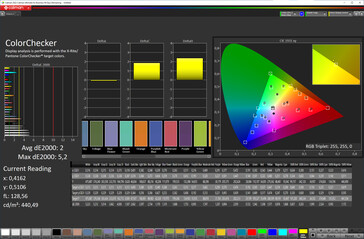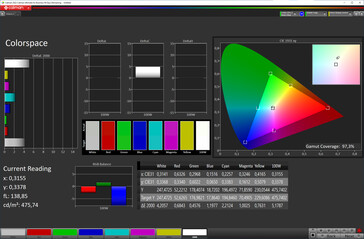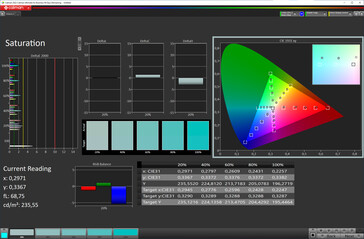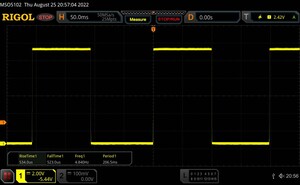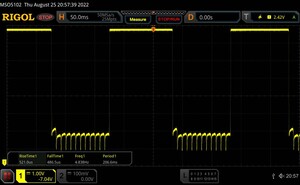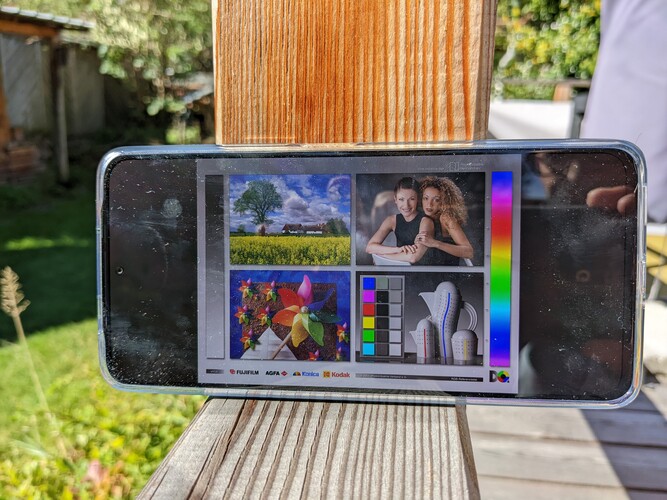Xiaomi Poco F4 review: Great smartphone, but lacking innovation
Poco F4? We've had this already. This is only nearly true, since Poco launched the F4 GT with the Snapdragon 8 Gen 1 processor in the summer. The F4 without GT, on the other hand, is the successor to last year's F3 model. The device is available in two configuration variants: the smaller one comes with 6 GB of RAM and 128 GB of storage, while the larger one offers 8 GB of RAM and 256 GB of storage. There are three colors to choose from: silver, black and green. Our review device is black and has the smaller storage configuration. We clarify whether the F4 achieves a top spot in terms of price-performance in the Poco tradition.
Possible Competitors in Comparison
Rating | Date | Model | Weight | Drive | Size | Resolution | Price |
|---|---|---|---|---|---|---|---|
| 86.4 % v7 (old) | 09 / 2022 | Xiaomi Poco F4 SD 870, Adreno 650 | 195 g | 128 GB UFS 3.1 Flash | 6.67" | 2400x1080 | |
| 83.4 % v7 (old) | 06 / 2022 | Samsung Galaxy A53 Exynos 1280, Mali-G68 MP4 | 189 g | 128 GB UFS 2.1 Flash | 6.50" | 2400x1080 | |
| 88.1 % v7 (old) | 03 / 2022 | Xiaomi 12X SD 870, Adreno 650 | 176 g | 256 GB UFS 3.1 Flash | 6.28" | 2400x1080 | |
| 86 % v7 (old) | 05 / 2021 | Xiaomi Poco F3 SD 870, Adreno 650 | 196 g | 128 GB UFS 3.1 Flash | 6.67" | 2400x1080 | |
| 86.4 % v7 (old) | 07 / 2022 | Motorola Edge 30 SD 778G+ 5G, Adreno 642L | 155 g | 128 GB UFS 3.1 Flash | 6.50" | 2400x1080 | |
| 85.4 % v7 (old) | 06 / 2022 | OnePlus Nord 2T Dimensity 1300, Mali-G77 MP9 | 190 g | 256 GB UFS 3.1 Flash | 6.43" | 2400x1080 | |
| 85.5 % v7 (old) | 12 / 2021 | Honor 50 SD 778G 5G, Adreno 642L | 175 g | 256 GB UFS 2.1 Flash | 6.57" | 2340x1080 |
Case - F4 with plastic frame and glass back
The Poco F4 has a glass back, with Xiaomi emphasizing a reduced thickness of 7.7 millimeters, but this does not include the protruding camera module. Although the cameras clearly protrude from the case, the smartphone does not wobble on a flat surface. The frame is made of plastic, but still ensures great rigidity. Edges are straight, making the smartphone look quite angular. The display is reinforced by Corning Gorilla Glass 5.
During the review period, our review sample did not incur any scratches or other signs of wear. The smartphone can be twisted a little under force, but there are no noises. The SIM card slot has a rubber seal, so the smartphone is presumably water resistant, even if IP certification is absent. The workmanship is very good overall, and the gaps very small and even.
Equipment - Poco with dual SIM and stereo sound
The Poco F4 is dual-SIM capable. It accepts two nano-SIM cards, but eSIM is not supported. The internal storage cannot be expanded with a micro-SD card, so the choice between the two storage variants with 128 and 256 GB should be carefully considered. The F4 also does without a jack, but Poco at least includes a jack to USB-C adapter. In return, the smartphone offers stereo speakers that are Dolby Atmos certified. There is also an infrared transmitter on the top, so the smartphone can be used as a remote control for many devices.
The power button and the volume rocker are installed on the right side of the device. Turning the smartphone on and off is no problem for right-handers, and the reviewer's thumb easily reaches the volume down button. However, the thumb has to be stretched out for the volume up button. The notification LED has been omitted. Instead, the F4 has an always-on display. Lastly, the panel can be activated by lifting it or double-tapping it to check for received messages.
Software - F4 runs on MIUI 13
Poco's affiliation with Xiaomi is made clear in the software, since the F4 runs MIUI 13, which is based on Android 12. At the time of review, the security patch was from August 2022. The UI has an app launcher and comes with pre-installed third-party apps such as Netflix, Audible, Amazon, Booking, Genshin Impact, Goboo, Joom, Lords Mobile, Spotify, TikTok and WPS Office, but these can all be uninstalled. In addition, a number of Google apps and programs from the Xiaomi universe, such as Mi Video, ShareMe, and Mi Remote, are installed. In total, 24 GB of storage space is already occupied in factory state.
The software supports some gestures and shortcuts for the keys. For example, users can take a screenshot via a three-finger swipe gesture or start the flashlight with a double tap on the power button. Such gestures can be customized in the menu. Poco also includes a one-hand mode that allows you to reach the entire display area with your thumb without having to change your grip.
The software also offers the option of side menus, which can be used to launch either individual programs or special functions in special usage scenarios. For example, the sidebar opens the "Game Turbo" when gaming, which can be used to quickly clean up the RAM or free up storage space. Quick access to screenshots is also possible. Furthermore, there is the option of implementing two user accounts on the device, which can be used in parallel.
The Poco software separates the notifications from the quick settings. A swipe down to the left of the selfie camera shows the current notifications, while a swipe to the right of the camera opens the quick settings. A swipe from bottom to top opens the app launcher, which can also filter the apps by categories such as communication, entertainment, photography etc. Currently, Poco and Xiaomi do not provide any precise information about an update schedule, but have stated their intention to provide the devices with updates in the long term.
Communication and GNSS - F4 comes with 5G and Wi-Fi 6
The Poco F4 supports all frequency bands relevant to Europe, including LTE and 5G mobile. Under testing, the smartphone's reception displayed no abnormalities. The Poco device accepts two nano-SIM cards; eSIM is not supported. The mmWave standard is also not supported
The Poco F4 performs well with Wi-Fi 6 support in the home network: The transfer rates with our Asus ROG Rapture GT-AXE11000 reference router are solid. Although the smartphone does not outperform competing devices - with the exception of the Samsung A53 - it still ranks among the top contenders. Similarly to its predecessor, the transfer rates are also very stable and there are no dips.
| Networking | |
| Xiaomi Poco F4 | |
| iperf3 receive AXE11000 | |
| iperf3 transmit AXE11000 | |
| Samsung Galaxy A53 | |
| iperf3 receive AXE11000 | |
| iperf3 transmit AXE11000 | |
| Xiaomi 12X | |
| iperf3 receive AXE11000 | |
| iperf3 transmit AXE11000 | |
| Xiaomi Poco F3 | |
| iperf3 transmit AX12 | |
| iperf3 receive AX12 | |
| Motorola Edge 30 | |
| iperf3 transmit AXE11000 6GHz | |
| iperf3 receive AXE11000 6GHz | |
| OnePlus Nord 2T | |
| iperf3 receive AXE11000 | |
| iperf3 transmit AXE11000 | |
| Honor 50 | |
| iperf3 transmit AX12 | |
| iperf3 receive AX12 | |
| Average of class Smartphone | |
| iperf3 receive AXE11000 | |
| iperf3 transmit AXE11000 | |
| iperf3 transmit AXE11000 6GHz | |
| iperf3 receive AXE11000 6GHz | |
Under testing, the Poco F4 proves to be quick in establishing links to satellite systems. The F4 supports GNSS with several bands. After an initial calibration, everyday navigation with Google Maps works well. Satellite positioning succeeds both indoors and outdoors within a few seconds.
In a bicycle ride with our comparison device, the Garmin Venu 2, the Poco F4 performs well with a good recording of the route traveled. The total distance recorded hardly deviates and corresponds to the satellite recording, even with curves and turns.
Telephony & Voice Quality
The call quality of the Poco F4 is inconspicuous. The other party is rendered clearly and the earpiece is loud enough. The user of the F4 is also well understood, but background noise could be filtered out better. For the phone app, Poco relies on software from Google. The user interface is tidy and clearly arranged.
The Poco F4 supports both VoLTE and calls via WLAN. When making calls via the loudspeaker, the F4 gives clear voice reproduction, especially in the mids and trebles. Voices are reproduced naturally and do not sound tinny, even at high volumes.
Cameras - Poco with 64 MPix update
The Poco F4 offers three different cameras on the back, two of which we know from the predecessor. The 64 MPix main camera is new and replaces the 48 MPix sensor of the F3. The new sensor impresses with a large dynamic range. Image processing is swift, although the software carries out a lot of post-image sharpening. The camera also offers a manual Pro mode where ISO, white balance, shutter speed, aperture and focus can be manually adjusted.
The leap in quality from the main to the wide-angle camera is enormous. Color reproduction deviates, the images appear paler, and there is also a lack of sharpness. The macro lens is more of a gimmick; in sufficient light, shots at close range are possible, but they lack sharpness. Video recordings are possible up to a resolution of 4K and 60 FPS, but only 1080p and 30 FPS are enabled ex-factory. The fast autofocus in video recordings is a positive aspect, but the recordings lack good stabilization and quickly become shaky.
A 20 MPix camera is used on the front, as in the predecessor. Poco specifies the camera recess in the display as having a diameter of only 2.67 millimeters. Good selfies are possible in good light conditions, but lens flares occur in backlight. Portrait mode works quickly and reliably, and even hair is not a problem for the camera. Video recordings are possible with a maximum resolution of 1080p and 30 FPS.
Image comparison
Choose a scene and navigate within the first image. One click changes the position on touchscreens. One click on the zoomed-in image opens the original in a new window. The first image shows the scaled photograph of the test device.
Main cameraMain cameraWide angle5x zoomLow lightIn terms of color fidelity, the Poco F4's camera does not come out unscathed. Most colors are greatly brightened in daylight, but appear vivid on their own. As expected, the differences are significantly larger under controlled lighting conditions at a brightness of just one lux. In a class comparison, the F4's camera performs remarkably well, although the Samsung A53 renders colors more realistically under identical conditions.
The sharpness of the images is good, but decreases noticeably towards the edges in our test chart. In addition, the exposure of the pictures is not uniform; the lower edge of the picture is brighter than the upper one. In low light, objects and details are still recognizable in the Poco pictures, but could be brighter overall.
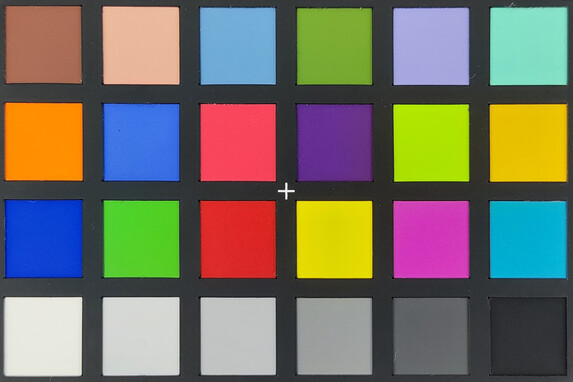

Accessories & Warranty - The F4 comes with a case and fast charger
The Poco F4 comes with a 67-watt fast charger (including a matching USB-A to USB-C cable), a transparent plastic case, a USB-C to jack adapter, a screen protector and a SIM card tool.
Xiaomi offers a 24-month warranty for Poco smartphones in Germany. This may differ in other regions, so be sure to check with your supplier before buying.
Input Devices & Operation - The F4 is quickly unlocked
Poco uses Google's Gboard keyboard ex-works, so inputs in portrait and landscape mode are smooth and usually without error. The capacitive panel supports inputs of up to ten fingers simultaneously. The sampling rate is up to 360 Hz and the screen's gliding properties are very good.
The smartphone can be unlocked via fingerprint and face recognition. The fingerprint sensor is located in the power button, and functions rapidly without erroneous inputs. Most of the time, however, the device is inadvertently unlocked by the more unsecure 2D facial recognition, which works extremely fast.
Display - The OLED panel of the F4 gets really bright
Poco has installed an OLED display with a refresh rate of up to 120 Hz in the F4. The rate can either be fixed at 60 or 120 Hz, or the software dynamically adjusts the refresh rates to the current content, in which case an average value of 90 Hz is also possible.
The 6.67-inch (16.94 cm) panel has a high brightness. In testing, we determined a maximum value of 1274 cd/m² with the ambient light sensor enabled, which nearly corresponds to the 1300 nits specified by Poco. The display reaches a maximum of 502 cd/m² with the sensor disabled. The illumination of the panel is also good; the differences between individual areas are small and not perceptible in everyday use.
The display is flat and without any curvature. Display edges are not particularly narrow, but very even. Poco offers an always-on display in the F4. The function can be customized in different styles. In addition, the function can be deactivated in certain periods so that you are not disturbed by an illuminated panel at night, for example.
We also measured the PWN. The frequency at the lowest brightness is 443 Hz. As soon as the brightness exceeds 51%, the frequency is 120 Hz, which corresponds to the refresh rate of the display. No temporal dithering was detected.
| |||||||||||||||||||||||||
Brightness Distribution: 96 %
Center on Battery: 917 cd/m²
Contrast: ∞:1 (Black: 0 cd/m²)
ΔE ColorChecker Calman: 2 | ∀{0.5-29.43 Ø4.78}
ΔE Greyscale Calman: 3.5 | ∀{0.09-98 Ø5}
97.3% sRGB (Calman 2D)
Gamma: 2.23
CCT: 6447 K
| Xiaomi Poco F4 AMOLED, 2400x1080, 6.7" | Samsung Galaxy A53 AMOLED, 2400x1080, 6.5" | Xiaomi 12X OLED, 2400x1080, 6.3" | Xiaomi Poco F3 AMOLED, 2400x1080, 6.7" | Motorola Edge 30 AMOLED, 2400x1080, 6.5" | OnePlus Nord 2T AMOLED, 2400x1080, 6.4" | Honor 50 OLED, 2340x1080, 6.6" | |
|---|---|---|---|---|---|---|---|
| Screen | 6% | 31% | 29% | 4% | -24% | -21% | |
| Brightness middle (cd/m²) | 917 | 718 -22% | 910 -1% | 889 -3% | 632 -31% | 561 -39% | 731 -20% |
| Brightness (cd/m²) | 923 | 730 -21% | 908 -2% | 902 -2% | 630 -32% | 573 -38% | 722 -22% |
| Brightness Distribution (%) | 96 | 92 -4% | 97 1% | 95 -1% | 92 -4% | 96 0% | 97 1% |
| Black Level * (cd/m²) | |||||||
| Colorchecker dE 2000 * | 2 | 1.62 19% | 0.8 60% | 0.9 55% | 1.46 27% | 2.67 -34% | 3.1 -55% |
| Colorchecker dE 2000 max. * | 5.2 | 4.21 19% | 1.8 65% | 1.9 63% | 3.32 36% | 6.15 -18% | 5.8 -12% |
| Greyscale dE 2000 * | 3.5 | 2 43% | 1.3 63% | 1.3 63% | 2.6 26% | 4.1 -17% | 4.2 -20% |
| Gamma | 2.23 99% | 2.156 102% | 2.25 98% | 2.26 97% | 2.209 100% | 2.245 98% | 2.19 100% |
| CCT | 6447 101% | 6545 99% | 6414 101% | 6614 98% | 6755 96% | 7104 91% | 6818 95% |
* ... smaller is better
Screen Flickering / PWM (Pulse-Width Modulation)
| Screen flickering / PWM detected | 443 Hz | ||
The display backlight flickers at 443 Hz (worst case, e.g., utilizing PWM) . The frequency of 443 Hz is relatively high, so most users sensitive to PWM should not notice any flickering. However, there are reports that some users are still sensitive to PWM at 500 Hz and above, so be aware. In comparison: 53 % of all tested devices do not use PWM to dim the display. If PWM was detected, an average of 8098 (minimum: 5 - maximum: 343500) Hz was measured. | |||
Series of measurements at a fixed zoom level and different brightness settings
Thanks to its design, the OLED display of the Poco F4 scores with a perfect black level and correspondingly excellent contrasts. The overall color reproduction is also pleasing; deviations are in the imperceptible range for almost all tones.
Only the grayscale and white values are out of line and show increased deviation. The 2D CalMAN test resulted in a coverage of the sRGB color space of up to 97.3%. In everyday use, the panel convinces with crisp color reproduction.
Display Response Times
| ↔ Response Time Black to White | ||
|---|---|---|
| 1.06 ms ... rise ↗ and fall ↘ combined | ↗ 0.534 ms rise | |
| ↘ 0.523 ms fall | ||
| The screen shows very fast response rates in our tests and should be very well suited for fast-paced gaming. In comparison, all tested devices range from 0.1 (minimum) to 240 (maximum) ms. » 4 % of all devices are better. This means that the measured response time is better than the average of all tested devices (20.2 ms). | ||
| ↔ Response Time 50% Grey to 80% Grey | ||
| 1.01 ms ... rise ↗ and fall ↘ combined | ↗ 0.521 ms rise | |
| ↘ 0.4865 ms fall | ||
| The screen shows very fast response rates in our tests and should be very well suited for fast-paced gaming. In comparison, all tested devices range from 0.165 (minimum) to 636 (maximum) ms. » 3 % of all devices are better. This means that the measured response time is better than the average of all tested devices (31.6 ms). | ||
Performance - The F4 is slower than its predecessor
Poco uses a combination of a Snapdragon 870 and an Adreno 650 in the F4 - just like the F3 predecessor. Even though newer processors are now on the market, the Poco F4 is still performs well with its built-in SoC. However, it also becomes clear in the CPU benchmarks that the Poco F4 is slightly behind the average smartphone with this processor and also lands behind its F3 predecessor.
Although Poco F4 has to admit defeat to its predecessor and the Xiaomi 12X with the same processor is faster, the other comparison devices don't stand a chance in the benchmarks. The Snapdragon 778G(+) in the Honor 50 and the Motorola Edge 30 are in a different performance class, as is the MediaTek Dimensity 1300 in the OnePlus Nord 2T and the Exynos 1280 in the Samsung Galaxy A53.
In everyday life, the Poco F4 hardly reaches its limits. Apps start quickly and run without jerks. Switching between different apps doesn't make the device sweat, nor does opening several apps in floating windows at the same time.
| CrossMark - Overall | |
| Average of class Smartphone (187 - 2674, n=123, last 2 years) | |
| Average Qualcomm Snapdragon 870 5G (719 - 844, n=8) | |
| Xiaomi Poco F4 | |
| Motorola Edge 30 | |
| Xiaomi 12X | |
| Samsung Galaxy A53 | |
| AImark - Score v2.x | |
| Xiaomi 12X | |
| Average Qualcomm Snapdragon 870 5G (111838 - 123847, n=9) | |
| Xiaomi Poco F4 | |
| Xiaomi Poco F3 | |
| OnePlus Nord 2T | |
| Motorola Edge 30 | |
| Samsung Galaxy A53 | |
The Poco F4 leaves a mixed impression in the GPU benchmarks. It leads the field of contenders in some GFX measurements, but mostly ranks in the middle. The smartphone is too fast for some onscreen tests, such as the Sling Shot Etreme OpenGL ES 3.1, so no results are displayed.
GFXBench (DX / GLBenchmark) 2.7: T-Rex Onscreen | 1920x1080 T-Rex Offscreen
GFXBench 3.0: on screen Manhattan Onscreen OGL | 1920x1080 1080p Manhattan Offscreen
GFXBench 3.1: on screen Manhattan ES 3.1 Onscreen | 1920x1080 Manhattan ES 3.1 Offscreen
GFXBench: on screen Car Chase Onscreen | 1920x1080 Car Chase Offscreen | on screen Aztec Ruins High Tier Onscreen | 2560x1440 Aztec Ruins High Tier Offscreen | on screen Aztec Ruins Normal Tier Onscreen | 1920x1080 Aztec Ruins Normal Tier Offscreen
| 3DMark / Wild Life Extreme Unlimited | |
| OnePlus Nord 2T | |
| Xiaomi 12X | |
| Xiaomi Poco F3 | |
| Xiaomi Poco F4 | |
| Motorola Edge 30 | |
| Honor 50 | |
| Samsung Galaxy A53 | |
| 3DMark / Wild Life Extreme | |
| OnePlus Nord 2T | |
| Xiaomi 12X | |
| Xiaomi Poco F3 | |
| Xiaomi Poco F4 | |
| Motorola Edge 30 | |
| Honor 50 | |
| Samsung Galaxy A53 | |
| 3DMark / Wild Life Unlimited Score | |
| OnePlus Nord 2T | |
| Xiaomi 12X | |
| Xiaomi Poco F4 | |
| Xiaomi Poco F3 | |
| Motorola Edge 30 | |
| Honor 50 | |
| Samsung Galaxy A53 | |
| 3DMark / Wild Life Score | |
| OnePlus Nord 2T | |
| Xiaomi 12X | |
| Xiaomi Poco F3 | |
| Xiaomi Poco F4 | |
| Motorola Edge 30 | |
| Honor 50 | |
| Samsung Galaxy A53 | |
| 3DMark / Sling Shot Extreme (ES 3.1) Unlimited Physics | |
| Xiaomi 12X | |
| Honor 50 | |
| Motorola Edge 30 | |
| Xiaomi Poco F4 | |
| Xiaomi Poco F3 | |
| Samsung Galaxy A53 | |
| 3DMark / Sling Shot Extreme (ES 3.1) Unlimited Graphics | |
| Xiaomi 12X | |
| Xiaomi Poco F4 | |
| Xiaomi Poco F3 | |
| Motorola Edge 30 | |
| Honor 50 | |
| Samsung Galaxy A53 | |
| 3DMark / Sling Shot Extreme (ES 3.1) Unlimited | |
| Xiaomi 12X | |
| Xiaomi Poco F4 | |
| Xiaomi Poco F3 | |
| Motorola Edge 30 | |
| Honor 50 | |
| Samsung Galaxy A53 | |
| 3DMark / Sling Shot OpenGL ES 3.0 Unlimited | |
| Xiaomi 12X | |
| Xiaomi Poco F4 | |
| Xiaomi Poco F3 | |
| Motorola Edge 30 | |
| Honor 50 | |
| Samsung Galaxy A53 | |
| 3DMark / Sling Shot OpenGL ES 3.0 Unlimited Graphics | |
| Xiaomi 12X | |
| Xiaomi Poco F4 | |
| Xiaomi Poco F3 | |
| Motorola Edge 30 | |
| Honor 50 | |
| Samsung Galaxy A53 | |
| 3DMark / Sling Shot OpenGL ES 3.0 Unlimited Physics | |
| Xiaomi 12X | |
| Motorola Edge 30 | |
| Honor 50 | |
| Xiaomi Poco F4 | |
| Xiaomi Poco F3 | |
| Samsung Galaxy A53 | |
| GFXBench (DX / GLBenchmark) 2.7 / T-Rex Onscreen | |
| Xiaomi 12X | |
| Honor 50 | |
| Motorola Edge 30 | |
| Samsung Galaxy A53 | |
| Xiaomi Poco F3 | |
| Xiaomi Poco F4 | |
| OnePlus Nord 2T | |
| GFXBench (DX / GLBenchmark) 2.7 / T-Rex Offscreen | |
| Xiaomi Poco F3 | |
| OnePlus Nord 2T | |
| Xiaomi Poco F4 | |
| Xiaomi 12X | |
| Motorola Edge 30 | |
| Honor 50 | |
| Samsung Galaxy A53 | |
| GFXBench 3.0 / Manhattan Onscreen OGL | |
| Xiaomi 12X | |
| Motorola Edge 30 | |
| Honor 50 | |
| Xiaomi Poco F3 | |
| Xiaomi Poco F4 | |
| OnePlus Nord 2T | |
| Samsung Galaxy A53 | |
| GFXBench 3.0 / 1080p Manhattan Offscreen | |
| OnePlus Nord 2T | |
| Xiaomi Poco F3 | |
| Xiaomi 12X | |
| Xiaomi Poco F4 | |
| Motorola Edge 30 | |
| Honor 50 | |
| Samsung Galaxy A53 | |
| GFXBench 3.1 / Manhattan ES 3.1 Onscreen | |
| Xiaomi 12X | |
| Motorola Edge 30 | |
| Xiaomi Poco F3 | |
| Xiaomi Poco F4 | |
| OnePlus Nord 2T | |
| Honor 50 | |
| Samsung Galaxy A53 | |
| GFXBench 3.1 / Manhattan ES 3.1 Offscreen | |
| Xiaomi Poco F3 | |
| OnePlus Nord 2T | |
| Xiaomi Poco F4 | |
| Xiaomi 12X | |
| Motorola Edge 30 | |
| Honor 50 | |
| Samsung Galaxy A53 | |
| GFXBench / Car Chase Onscreen | |
| Xiaomi 12X | |
| Xiaomi Poco F3 | |
| Xiaomi Poco F4 | |
| OnePlus Nord 2T | |
| Motorola Edge 30 | |
| Honor 50 | |
| Samsung Galaxy A53 | |
| GFXBench / Car Chase Offscreen | |
| OnePlus Nord 2T | |
| Xiaomi Poco F4 | |
| Xiaomi Poco F3 | |
| Xiaomi 12X | |
| Motorola Edge 30 | |
| Honor 50 | |
| Samsung Galaxy A53 | |
| GFXBench / Aztec Ruins High Tier Onscreen | |
| Xiaomi Poco F3 | |
| OnePlus Nord 2T | |
| Xiaomi Poco F4 | |
| Xiaomi 12X | |
| Motorola Edge 30 | |
| Honor 50 | |
| Samsung Galaxy A53 | |
| GFXBench / Aztec Ruins High Tier Offscreen | |
| Xiaomi Poco F3 | |
| Xiaomi Poco F4 | |
| Xiaomi 12X | |
| Motorola Edge 30 | |
| Honor 50 | |
| Samsung Galaxy A53 | |
| OnePlus Nord 2T | |
| GFXBench / Aztec Ruins Normal Tier Onscreen | |
| Xiaomi Poco F4 | |
| Xiaomi Poco F3 | |
| Xiaomi 12X | |
| OnePlus Nord 2T | |
| Motorola Edge 30 | |
| Honor 50 | |
| Samsung Galaxy A53 | |
| GFXBench / Aztec Ruins Normal Tier Offscreen | |
| Xiaomi Poco F4 | |
| Xiaomi Poco F3 | |
| OnePlus Nord 2T | |
| Xiaomi 12X | |
| Motorola Edge 30 | |
| Honor 50 | |
| Samsung Galaxy A53 | |
Classifying the results of the browser benchmarks is difficult because the achieved results vary strongly, depending on the browser selected. In Chrome, the Poco F4 falls in the last or one of the last places in the comparison field in the Octane 2.0 and Jetstream 2 tests. In Edge, on the other hand, the smartphone's scores are in the upper range of competing smartphones. The Poco UI thus does not seem to harmonize particularly well with the current Chrome version when it comes to top performance. Scores for the Speedometer 2.0 benchmark are similar in both browsers and on a low level. In everyday use, no performance issues occur while browsing, no matter which browser is chosen. Pages load smoothly, and even many simultaneously opened browser tabs do not cause the system to jerk or crash.
| Jetstream 2 - 2.0 Total Score | |
| Average of class Smartphone (23.8 - 387, n=149, last 2 years) | |
| Xiaomi 12X (Chrome 98.0.4758.101) | |
| Xiaomi Poco F4 (Edge 105) | |
| Motorola Edge 30 (Chrome 102.0.5005.125) | |
| Average Qualcomm Snapdragon 870 5G (60.7 - 108.3, n=12) | |
| Honor 50 (Chrome 96) | |
| Xiaomi Poco F3 (Chrome 90) | |
| OnePlus Nord 2T (Chrome 102) | |
| Samsung Galaxy A53 (Chrome 101) | |
| Speedometer 2.0 - Result 2.0 | |
| Average of class Smartphone (15.2 - 643, n=122, last 2 years) | |
| Xiaomi Poco F3 (Chrome 90) | |
| Xiaomi 12X (Chrome 98.0.4758.101) | |
| Average Qualcomm Snapdragon 870 5G (51.4 - 77, n=12) | |
| Motorola Edge 30 (Chrome 102.0.5005.125) | |
| OnePlus Nord 2T (Chome 102) | |
| Xiaomi Poco F4 (Edge 105) | |
| Samsung Galaxy A53 (Chome 101) | |
| WebXPRT 3 - Overall | |
| Average of class Smartphone (38 - 380, n=31, last 2 years) | |
| Xiaomi 12X (Chrome 98.0.4758.101) | |
| Average Qualcomm Snapdragon 870 5G (94 - 155, n=13) | |
| Xiaomi Poco F3 (Chrome 90) | |
| Motorola Edge 30 (Chrome 102.0.5005.125) | |
| Xiaomi Poco F4 (chrome 103) | |
| Honor 50 (Chrome 96) | |
| Samsung Galaxy A53 (Chrome 101) | |
| OnePlus Nord 2T (Chrome 102) | |
| Octane V2 - Total Score | |
| Average of class Smartphone (2228 - 121337, n=197, last 2 years) | |
| Xiaomi 12X (Chrome 98.0.4758.101) | |
| Xiaomi Poco F4 (Edge 105) | |
| OnePlus Nord 2T (Chrome 102) | |
| Average Qualcomm Snapdragon 870 5G (20543 - 41256, n=13) | |
| Motorola Edge 30 (Chrome 102.0.5005.125) | |
| Honor 50 (Chrome 96) | |
| Xiaomi Poco F3 (Chrome 90) | |
| Samsung Galaxy A53 (Chrome 101) | |
| Mozilla Kraken 1.1 - Total | |
| Samsung Galaxy A53 (Chrome 101) | |
| Xiaomi Poco F4 (chrome 103) | |
| Xiaomi Poco F3 (Chrome 90) | |
| Honor 50 (Chrome 96) | |
| OnePlus Nord 2T (Chrome 102) | |
| Average Qualcomm Snapdragon 870 5G (1055 - 1792, n=13) | |
| Motorola Edge 30 (Chrome 102.0.5005.125) | |
| Average of class Smartphone (257 - 28190, n=155, last 2 years) | |
| Xiaomi 12X (Chrome 98.0.4758.101) | |
* ... smaller is better
The Poco F4 comes in two storage variants with 128 and 256 GB. Further expansion of the storage via microSD card is not possible. Our review sample is the small version; 104 GB is available in factory state. Poco uses UFS 3.1 storage, which clearly lags behind the results of the Xiaomi 12X and the OnePlus Nord 2T in the test field. The F4 seems to have the same memory as the F3 because the measured values are very similar. In sequential read and write, the Poco F4 is slightly below the device average with UFS 3.1 storage, but is slightly above average in the random values.
| Xiaomi Poco F4 | Samsung Galaxy A53 | Xiaomi 12X | Xiaomi Poco F3 | Motorola Edge 30 | OnePlus Nord 2T | Honor 50 | Average 128 GB UFS 3.1 Flash | Average of class Smartphone | |
|---|---|---|---|---|---|---|---|---|---|
| AndroBench 3-5 | -16% | 35% | -1% | 26% | 46% | 8% | 20% | 89% | |
| Sequential Read 256KB (MB/s) | 1371.56 | 510.1 -63% | 1732 26% | 1378 0% | 1514.62 10% | 1891.3 38% | 984 -28% | 1569 ? 14% | 2228 ? 62% |
| Sequential Write 256KB (MB/s) | 701.06 | 486.7 -31% | 795 13% | 684 -2% | 965.35 38% | 1300.6 86% | 609 -13% | 768 ? 10% | 1852 ? 164% |
| Random Read 4KB (MB/s) | 183.61 | 229.9 25% | 291.9 59% | 208 13% | 241.72 32% | 235.8 28% | 245.7 34% | 244 ? 33% | 296 ? 61% |
| Random Write 4KB (MB/s) | 200.41 | 210.8 5% | 279.9 40% | 170.6 -15% | 249.14 24% | 262.2 31% | 280.2 40% | 243 ? 21% | 339 ? 69% |
Gaming - The F4 offers sufficient performance for current titles
The combination of Snapdragon 870 and Adreno 650 makes the Poco F4 a solid gaming smartphone. Current titles such as PUBG Mobile or League of Legends Wild Rift can be played at the highest or very high settings. The F4 also achieves high frame rates in simpler titles such as Deag Trigger 2, although these sometimes fluctuate strongly in high graphics settings, which is shown by the measurements in Gamebench. Nevertheless, the frame drops do not prove bothersome in-game, and the rate does not drop below 70 FPS. When PUBG Mobile is played at the highest settings, the frame rate is only 40 FPS, but remains very stable and the game is always smooth. The positioning of the stereo speakers, which are not covered during gaming, is good.
Emissions - Poco has the Snapdragon under control
Temperature - Poco stays cool even under load
The Poco F4 stays pleasantly cool on both the front and back during everyday use. Even under load, such as during gaming or stress tests, only individual areas of the smartphone get a bit warmer, especially in the area next to the camera. Overall, the Poco never gets hot and so can always be held without discomfort. The manufacturer states that a seven-layer graphite structure, in combination with a 3.1 mm² evaporation cooling chamber, is responsible for the chip's temperature management. This system works well in practice and cools the Snapdragon 870 reliably.
(+) The maximum temperature on the upper side is 31.7 °C / 89 F, compared to the average of 35.2 °C / 95 F, ranging from 21.9 to 247 °C for the class Smartphone.
(+) The bottom heats up to a maximum of 31.6 °C / 89 F, compared to the average of 34 °C / 93 F
(+) In idle usage, the average temperature for the upper side is 27 °C / 81 F, compared to the device average of 32.9 °C / 91 F.
3DMark Wild Life Stress Test
| 3DMark | |
| Wild Life Stress Test Stability | |
| Samsung Galaxy A53 | |
| Honor 50 | |
| Motorola Edge 30 | |
| Xiaomi Poco F4 | |
| Xiaomi Poco F3 | |
| Xiaomi 12X | |
| OnePlus Nord 2T | |
| Wild Life Extreme Stress Test | |
| Honor 50 | |
| Motorola Edge 30 | |
| Samsung Galaxy A53 | |
| Xiaomi Poco F4 | |
| Xiaomi Poco F3 | |
| Xiaomi 12X | |
| OnePlus Nord 2T | |
Speakers
The Poco F4 has stereo speakers that are Dolby Atmos certified and are located on the device's front sides. The smartphone's maximum volume is 86.2 dB, which makes the F4 quite loud and suitable for entertainment in loud surroundings. The sound does not become tinny, even at high volumes, and there is only slight vibration in the bottom third of the device. The speakers reproduce mids and trebles quite linearly, but bass or lower frequencies are lacking.
The F4 does not offer a jack connection, but Poco includes a USB-C to audio jack adapter with the smartphone. The audio output via Bluetooth worked flawlessly with several headphones under testing. The smartphone supports a number of audio codecs such as SBC, AAC, aptX (HD / Adaptive Audio / TWS+), LDAC and LHDC (V1-4).
Xiaomi Poco F4 audio analysis
(+) | speakers can play relatively loud (86.2 dB)
Bass 100 - 315 Hz
(-) | nearly no bass - on average 22.4% lower than median
(±) | linearity of bass is average (10.6% delta to prev. frequency)
Mids 400 - 2000 Hz
(±) | higher mids - on average 5.2% higher than median
(+) | mids are linear (4.1% delta to prev. frequency)
Highs 2 - 16 kHz
(+) | balanced highs - only 4.9% away from median
(+) | highs are linear (4.7% delta to prev. frequency)
Overall 100 - 16.000 Hz
(±) | linearity of overall sound is average (18.4% difference to median)
Compared to same class
» 19% of all tested devices in this class were better, 9% similar, 72% worse
» The best had a delta of 11%, average was 35%, worst was 134%
Compared to all devices tested
» 40% of all tested devices were better, 8% similar, 52% worse
» The best had a delta of 4%, average was 24%, worst was 134%
Xiaomi Poco F3 audio analysis
(+) | speakers can play relatively loud (89.4 dB)
Bass 100 - 315 Hz
(-) | nearly no bass - on average 28.2% lower than median
(±) | linearity of bass is average (9.8% delta to prev. frequency)
Mids 400 - 2000 Hz
(+) | balanced mids - only 4.7% away from median
(+) | mids are linear (4.5% delta to prev. frequency)
Highs 2 - 16 kHz
(+) | balanced highs - only 2.9% away from median
(+) | highs are linear (3.5% delta to prev. frequency)
Overall 100 - 16.000 Hz
(±) | linearity of overall sound is average (17% difference to median)
Compared to same class
» 9% of all tested devices in this class were better, 7% similar, 84% worse
» The best had a delta of 11%, average was 35%, worst was 134%
Compared to all devices tested
» 30% of all tested devices were better, 8% similar, 62% worse
» The best had a delta of 4%, average was 24%, worst was 134%
Battery Life - F4 does not live up to its potential
Power Consumption
The Poco F4 convinces across the board in terms of power consumption and is one of the best in its class. The smartphone performs well with low rates under load as well as in normal operation. Striking is the fact that the rates under load are significantly lower than those of the F3 predecessor and the Xiaomi 12X, which both use the same SoC.
The Poco smartphone charges from 10 to 100 percent in 45 minutes with the 67-watt power supply. It only takes 10 minutes to charge the device from 10 to 50 percent, and it only gets lukewarm in the process. Wireless charging is not supported.
| Off / Standby | |
| Idle | |
| Load |
|
Key:
min: | |
| Xiaomi Poco F4 4500 mAh | Samsung Galaxy A53 5000 mAh | Xiaomi 12X 4500 mAh | Xiaomi Poco F3 4520 mAh | Motorola Edge 30 4020 mAh | OnePlus Nord 2T 4500 mAh | Honor 50 4300 mAh | Average Qualcomm Snapdragon 870 5G | Average of class Smartphone | |
|---|---|---|---|---|---|---|---|---|---|
| Power Consumption | -18% | -28% | -11% | -3% | -9% | -57% | -64% | -38% | |
| Idle Minimum * (Watt) | 0.8 | 0.9 -13% | 0.75 6% | 0.76 5% | 0.9 -13% | 0.9 -13% | 1.02 -28% | 1.23 ? -54% | 0.842 ? -5% |
| Idle Average * (Watt) | 1.29 | 1.3 -1% | 1.88 -46% | 1.29 -0% | 1.2 7% | 1.3 -1% | 2.98 -131% | 2.17 ? -68% | 1.439 ? -12% |
| Idle Maximum * (Watt) | 1.38 | 1.6 -16% | 1.94 -41% | 1.45 -5% | 1.5 -9% | 1.7 -23% | 3.11 -125% | 2.49 ? -80% | 1.624 ? -18% |
| Load Average * (Watt) | 3.78 | 5.7 -51% | 4.99 -32% | 4.6 -22% | 3.6 5% | 4 -6% | 3.59 5% | 6.39 ? -69% | 7.03 ? -86% |
| Load Maximum * (Watt) | 6.71 | 7.3 -9% | 8.66 -29% | 8.87 -32% | 7.1 -6% | 6.8 -1% | 7.12 -6% | 9.94 ? -48% | 11.3 ? -68% |
* ... smaller is better
Power Consumption: Geekbench (150 cd/m²)
Power Consumption: GFXBench (150 cd/m²)
Battery Life
Although the power consumption values of the Poco F4 are very good, the battery life is shorter compared to comparison devices. This is not due to the size of the energy storage, which at 4,500 mAh belongs to the class average category. Only the Motorola Edge 30 has a 4,000 mAh battery, but that even lasts longer than the Poco F4 in three out of four tests.
The F4's scores are also lower than those of its predecessor. Since the hardware is the same in most areas, hope remains that the runtimes may be improved with a software update. Regardless of the comparison with other devices, you can get through the day well enough with the F4 without recharging, even if it is used frequently.
| Xiaomi Poco F4 4500 mAh | Samsung Galaxy A53 5000 mAh | Xiaomi 12X 4500 mAh | Xiaomi Poco F3 4520 mAh | Motorola Edge 30 4020 mAh | OnePlus Nord 2T 4500 mAh | Honor 50 4300 mAh | |
|---|---|---|---|---|---|---|---|
| Battery runtime | 34% | 48% | 18% | 8% | 32% | 36% | |
| Reader / Idle (h) | 22.4 | 40.5 81% | 35.3 58% | 26 16% | 26.7 19% | 32.3 44% | |
| H.264 (h) | 15.5 | 19.1 23% | 23 48% | 15.3 -1% | 16.7 8% | 19.3 25% | |
| WiFi v1.3 (h) | 11.1 | 14.8 33% | 17.1 54% | 13.4 21% | 10.6 -5% | 15.8 42% | 15.1 36% |
| Load (h) | 4.1 | 4.1 0% | 5.4 32% | 5.5 34% | 4.5 10% | 4.7 15% |
Pros
Cons
Verdict - Poco F4 a convincing package overall
The Poco F4 is a great smartphone. The SoC still offers an enormous amount of performance, even if the chip is no longer the newest. Regardless of whether it's multitasking or current games, the smartphone's performance is sufficient and should also hold out in the coming years. The display is also a joy to look at. Colors are crisp and the OLED panel gets really bright when needed, so outdoor use is no problem at all. This makes the F4 very suitable for media consumption because the stereo speakers are also decent. In terms of photos and videos, the 64 MPix main camera is particularly impressive. The wide-angle lens is useful and the macro lens is a nice, decorative accessory. Overall, photos are pleasing, including the selfies. The generous scope of delivery with case, screen protector and strong 67-watt fast charger rounds off our overall positive impression. However, the Poco F4 hardly differs from its predecessor. A change is definitely not worthwhile because there are no significant changes apart from the design and the main camera.
The Poco F4 offers a great overall package, but is lacking in improvements or innovation.
Those who are looking for the best performance should take a look at Poco's F4 GT with its Snapdragon 8 Gen 1, but the camera setup is identical there. Bargain hunters are better off with the F3, which is available at a lower price with almost the same configuration.
Price and Availability
Xiaomi Poco F4
- 09/19/2022 v7 (old)
Benedikt Winkel




